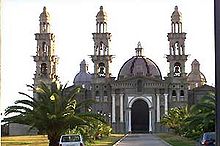El Palmar de Troya: Difference between revisions
Content deleted Content added
+ |
|||
| Line 2: | Line 2: | ||
{{Infobox settlement}} |
{{Infobox settlement}} |
||
[[Image:cathedralelpalmar.jpg|thumb|right|The cathedral of Palmar de Troya]] |
[[Image:cathedralelpalmar.jpg|thumb|right|The cathedral of Palmar de Troya]] |
||
'''El Palmar de Troya''' is a [[ |
'''El Palmar de Troya''' is a [[town]] near the city of [[Utrera]], in [[Andalusia]] in southwestern [[Spain]]. In 2018, it became segregated from Utrera and became a new ''[[municipio]]''.<ref>{{cite news |last1=Jabois |first1=Manuel |title=La independencia de El Palmar de Troya |url=https://elpais.com/politica/2018/11/16/actualidad/1542396151_864139.html |accessdate=5 October 2020 |work=El País |date=17 November 2018 |language=es}}</ref> |
||
With a population of 2,423, it is particularly known for the [[Cathedral-Basilica of Our Crowned Mother of Palmar|cathedral]] of the [[Palmarian Catholic Church]], a [[schism (religion)|schismatic]] [[Catholic]] sect founded by [[Clemente Domínguez y Gómez]], known as "Pope Gregory XVII" in the Palmarian Catholic faith since August 6, 1978 as a result of alleged apparitions of the [[Virgin Mary]] ([[Our Lady of Palmar]]) and of [[Jesus Christ]] on the site from the 1960s. He was later claimed as [[Antipope#Modern claimants to papacy|true Pope of whole Catholic faith]], instead of the accepted Cardinal Karol Józef Wojtyła, who took the name of [[John Paul II]]. |
With a population of 2,423, it is particularly known for the [[Cathedral-Basilica of Our Crowned Mother of Palmar|cathedral]] of the [[Palmarian Catholic Church]], a [[schism (religion)|schismatic]] [[Catholic]] sect founded by [[Clemente Domínguez y Gómez]], known as "Pope Gregory XVII" in the Palmarian Catholic faith since August 6, 1978 as a result of alleged apparitions of the [[Virgin Mary]] ([[Our Lady of Palmar]]) and of [[Jesus Christ]] on the site from the 1960s. He was later claimed as [[Antipope#Modern claimants to papacy|true Pope of whole Catholic faith]], instead of the accepted Cardinal Karol Józef Wojtyła, who took the name of [[John Paul II]]. |
||
==References== |
==References== |
||
{{reflist}} |
|||
<references/> |
|||
{{coord|37|03|45|N|5|48|15|W|type:city(2800)_region:ES-AN|display=title}} |
{{coord|37|03|45|N|5|48|15|W|type:city(2800)_region:ES-AN|display=title}} |
||
Revision as of 17:09, 5 October 2020
El Palmar de Troya |
|---|

El Palmar de Troya is a town near the city of Utrera, in Andalusia in southwestern Spain. In 2018, it became segregated from Utrera and became a new municipio.[1]
With a population of 2,423, it is particularly known for the cathedral of the Palmarian Catholic Church, a schismatic Catholic sect founded by Clemente Domínguez y Gómez, known as "Pope Gregory XVII" in the Palmarian Catholic faith since August 6, 1978 as a result of alleged apparitions of the Virgin Mary (Our Lady of Palmar) and of Jesus Christ on the site from the 1960s. He was later claimed as true Pope of whole Catholic faith, instead of the accepted Cardinal Karol Józef Wojtyła, who took the name of John Paul II.
References
- ^ Jabois, Manuel (17 November 2018). "La independencia de El Palmar de Troya". El País (in Spanish). Retrieved 5 October 2020.
37°03′45″N 5°48′15″W / 37.06250°N 5.80417°W
